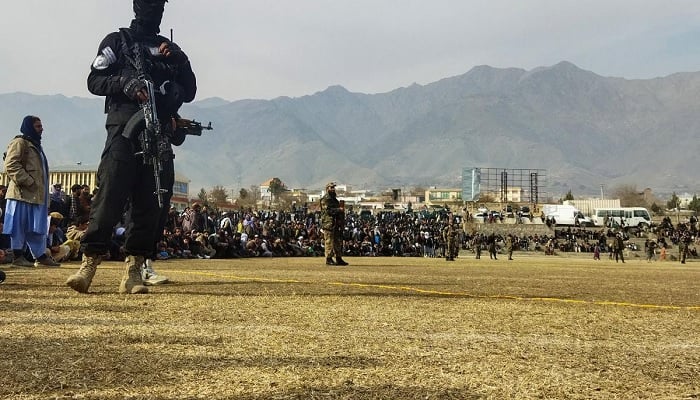Four men were publicly executed in Afghanistan on Friday, the Supreme Court announced, marking the highest number of executions carried out in a single day since the Taliban’s return to power.
The executions, which took place at sports stadiums in three provinces, have brought the total number of men publicly put to death since 2021 to 10, according to an AFP tally.
Public executions were a common practice during the Taliban’s initial rule from 1996 to 2001, with the majority conducted publicly in sports stadiums.
In Qala-i-Naw, the central city of Badghis province, witnesses informed an AFP journalist that two men were shot approximately six or seven times by a male relative of the victims in front of spectators.
“They were made to sit and turn their backs to us. Relatives from the victims’ families stood behind and shot them with a gun,” recounted Mohammad Iqbal Rahimyar, a 48-year-old spectator, to AFP.
The Supreme Court stated that the men had been “sentenced to retaliatory punishment” for fatally shooting other men, following a process where their cases were “examined very precisely and repeatedly.”
The families of the victims declined the opportunity to grant the men amnesty, the court added.
“If the family of the victim had forgiven the men it would be better, otherwise it’s God’s order, and should be implemented,” commented a 35-year-old man identifying himself as Zabihullah to AFP outside the stadium.
Official notices, widely circulated on Thursday, had invited Afghans to “attend the event.”
The Supreme Court further reported that a third man was executed in Zaranj in Nimroz province, and the fourth in Farah city in the western province of the same name.
“It’s good that the Islamic Emirate shows its politics and force. I am very happy with that,” remarked another 30-year-old spectator named Javid, using the Taliban government’s official title.
Amnesty International issued a call for the Taliban authorities to halt public executions, denouncing them as a “gross affront to human dignity.”
Eye for an Eye
The preceding execution occurred in November 2024, when a convicted murderer was shot three times in the chest by a member of the victim’s family in front of thousands of spectators, including high-ranking Taliban officials, at a stadium in Gardez, the capital of eastern Paktia province.
Corporal punishment – predominantly flogging – has been prevalent under the Taliban authorities and applied to offenses including theft, adultery, and alcohol consumption.
However, all execution orders require the signature of the Taliban’s reclusive Supreme Leader Hibatullah Akhundzada, who resides in the movement’s stronghold of Kandahar.
In 2022, Akhundzada instructed judges to fully implement all aspects of the Taliban government’s interpretation of Islamic law – including “eye-for-an-eye” punishments known as qisas, which permit the death penalty as retribution for the crime of murder.
Law and order are central to the strict ideology of the Taliban, which emerged from the chaos of a civil war following the withdrawal of Soviet forces from Afghanistan in 1989.
One of the most notorious images from their first rule depicted the 1999 execution of a woman wearing an all-covering burqa in a Kabul stadium. She had been accused of murdering her husband.
The United Nations and human rights organizations such as Amnesty have condemned the Taliban government’s use of corporal punishment and the death penalty.
Amnesty included Afghanistan among countries where “death sentences were known to have been imposed after proceedings that did not meet international fair trial standards,” the non-governmental organization stated in its annual report on death sentences published in April.
The 1,518 executions recorded globally in 2024 did not include the thousands of individuals believed to have been executed in China – the world’s leading practitioner of capital punishment, according to Amnesty.



